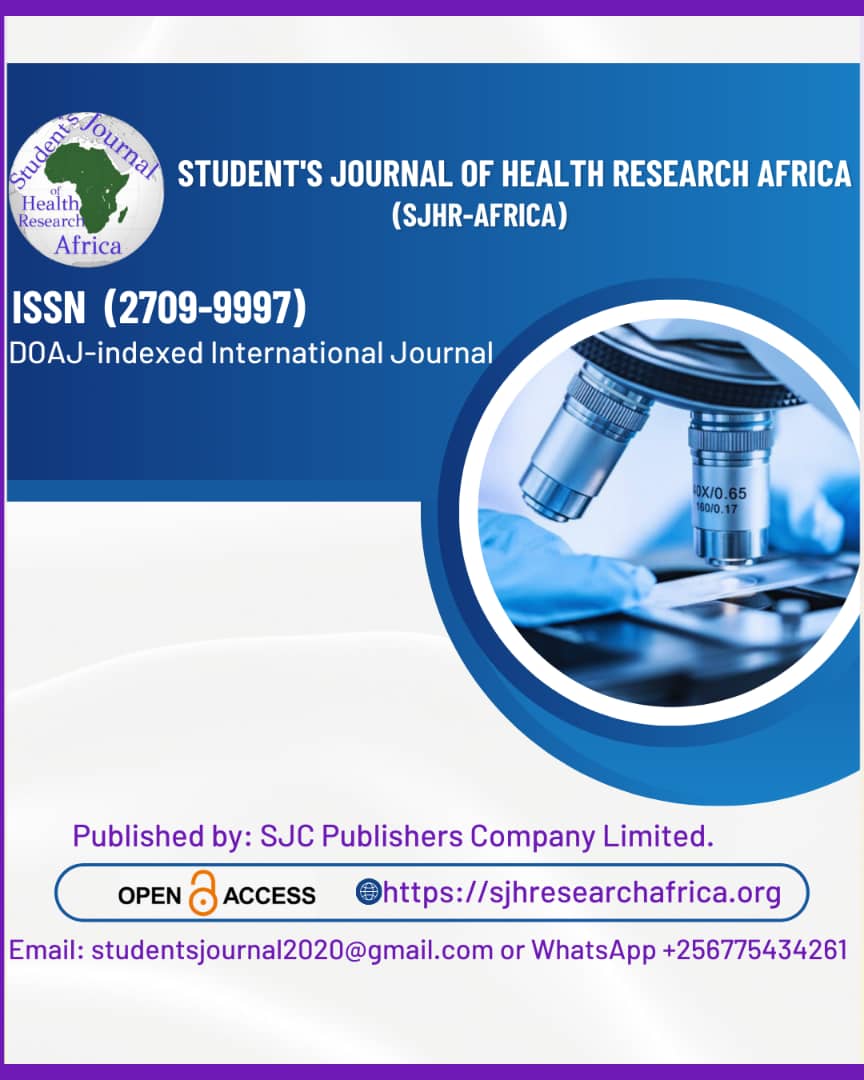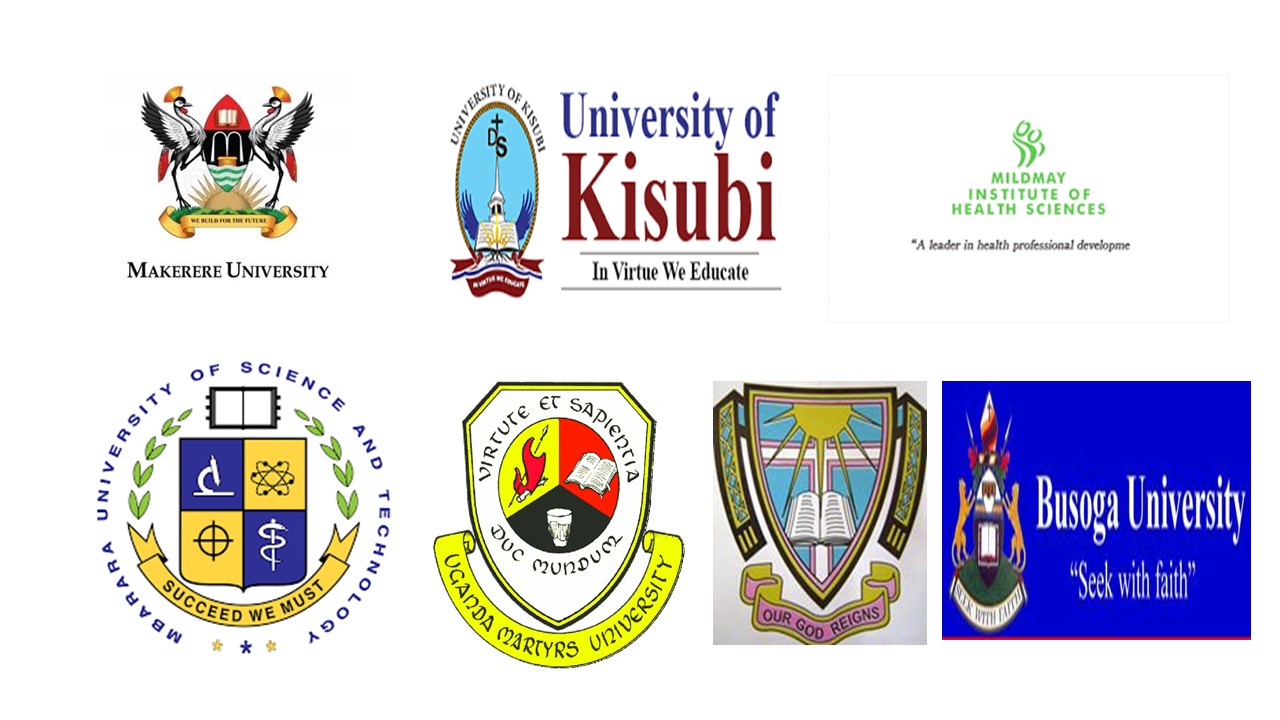Antibiotic resistance patterns of bacterial isolates from raw milk sold in coolers in Kawuku, Entebbe, Wakiso district.
DOI:
https://doi.org/10.51168/sjhrafrica.v6i9.2098Keywords:
Raw milk, antimicrobial resistance, bacterial pathogens, Kawuku, Uganda, public healthAbstract
Background:
Milk is an essential animal-derived food that provides proteins, vitamins, and minerals vital for human growth and metabolism. However, raw milk is a major vehicle for foodborne pathogens. This study aimed to determine the resistance patterns of pathogenic bacterial species in raw milk sold in coolers in Kawuku Entebbe Wakiso District.
Methodology:
This laboratory-based cross-sectional study aimed to determine the prevalence of bacterial pathogens and their antimicrobial resistance patterns in raw milk sold from coolers in Kawuku. A total of 20 raw milk samples were aseptically collected from selected milk stalls between January and February 2025 and analyzed using standard microbiological techniques. Bacterial identification was carried out through culture, Gram staining, and biochemical tests, while antimicrobial susceptibility testing was performed using the Kirby–Bauer disc diffusion method in accordance with CLSI guidelines.
Results:
Staphylococcus saprophyticus (23.3%) and Escherichia coli (16.7%) were the most prevalent pathogens, followed by Klebsiella pneumoniae and Proteus mirabilis (10.0% each). Other bacteria, including S. aureus, E. faecalis, and Citrobacter freundii, were also detected in varying proportions. Antimicrobial susceptibility testing demonstrated high resistance to Cefoxitin (CX5), Tetracycline (TE30), and Penicillin G (P10), while Ciprofloxacin (CIP5), Vancomycin (VA30), and Levofloxacin (LEV15) exhibited higher efficacy. Resistance patterns varied significantly across organisms and media types, with Gram-negative isolates showing more resistance to commonly used antibiotics.
Conclusion:
Raw milk sold in Kawuku is contaminated with multiple pathogenic bacteria exhibiting significant antimicrobial resistance.
Recommendation:
Further molecular-level studies are recommended to understand the genetic mechanisms driving resistance.
References
Ababu, A., Endashaw, D., & Fesseha, H. (2020). Isolation and antimicrobial susceptibility profile of Escherichia coli O157: H7 from raw milk of dairy cattle in Holeta district, Central Ethiopia. International Journal of Microbiology, 2020, 1-8. https://doi.org/10.1155/2020/6626488
Abolghait, S. K., Fathi, A. G., Youssef, F. M., & Algammal, A. M. (2020). Methicillin-resistant Staphylococcus aureus (MRSA) isolated from chicken meat and giblets often produces staphylococcal enterotoxin B (SEB) in non-refrigerated raw chicken livers. International journal of food microbiology, 328, 108669. https://doi.org/10.1016/j.ijfoodmicro.2020.108669
Algammal, A. M., Hetta, H. F., Batiha, G. E., Hozzein, W. N., El Kazzaz, W. M., Hashem, H. R., ... & El-Tarabili, R. M. (2020). Virulence-determinants and antibiotic-resistance genes of MDR-E. Coli isolated from secondary infections following the FMD outbreak in cattle. Scientific reports, 10(1), 19779. https://doi.org/10.1038/s41598-020-75914-9
Aliyo, A., & Teklemariam, Z. (2022). Assessment of milk contamination, associated risk factors, and drug sensitivity patterns among isolated bacteria from raw milk of the Borena zone, Ethiopia. Journal of Tropical Medicine, 2022. https://doi.org/10.1155/2022/3577715
Aliyo, A., Seyoum, A., & Teklemariam, Z. (2022). Bacteriological quality and antimicrobial susceptibility patterns among raw milk producers and vendors in Gomole district, Borena zone, Southern Ethiopia. Infection and Drug Resistance, 2589-2602. https://doi.org/10.2147/IDR.S364578
Bleasdale, M., Richter, K. K., Janzen, A., Brown, S., Scott, A., Zech, J., ... & Boivin, N. (2021). Ancient proteins provide evidence of dairy consumption in eastern Africa. Nature communications, 12(1), 632. https://doi.org/10.1038/s41467-020-20682-3
Brown, K., Mugoh, M., Call, D. R., & Omulo, S. (2020). Antibiotic residues and antibiotic-resistant bacteria were detected in milk marketed for human consumption in Kibera, Nairobi. Plos one, 15(5), e0233413. https://doi.org/10.1371/journal.pone.0233413
Chengat Prakashbabu, B., Cardwell, J. M., Craighead, L., Ndour, A. P. N., Yempabou, D., Ba, E., ... & Guitian, J. (2020). "We never boil our milk, it will cause sore udders and mastitis in our cows"-consumption practices, knowledge, and milk safety awareness in Senegal. BMC Public Health, 20(1), 1-12. https://doi.org/10.1186/s12889-020-08877-1
Hassani, S., Moosavy, M. H., Gharajalar, S. N., Khatibi, S. A., Hajibemani, A., & Barabadi, Z. (2022). High prevalence of antibiotic resistance in pathogenic foodborne bacteria isolated from bovine milk. Scientific Reports, 12(1), 3878. https://doi.org/10.1038/s41598-022-07845-6
Kumar, A., Panda, A. K., & Sharma, N. (2021). Determination of antibiotic residues in bovine milk by HPLC-DAD and assessment of human health risks in the Northwestern Himalayan region, India. Journal of Food Science and Technology, 1-10. https://doi.org/10.1007/s13197-021-04988-8
Kumar, A., Sowmiya, M., & Devi, T. (2018). Screening of E. coli for its antimicrobial susceptibility pattern in milk and dairy products in Chennai, India. IJCS, 6(2), 35-37.
Liu, H., Dong, L., Zhao, Y., Meng, L., Wang, J., Wang, C., & Zheng, N. (2022). Antimicrobial susceptibility and molecular characterization of Staphylococcus aureus isolated from different raw milk samples in China. Frontiers in Microbiology, 13, 840670. https://doi.org/10.3389/fmicb.2022.840670
Mailafia, S., Olatunde, H. O., Okoh, G., Chinyere, J., Adamu, S. G., & Onyilokwu, S. A. (2017). MicrobatTM 24E system identification and antimicrobial sensitivity pattern of bacterial flora from raw milk of apparently healthy lactating cows in Gwagwalada, Nigeria. J Coast Life Med, 5, 356-359. https://doi.org/10.12980/jclm.5.2017J7-46
Michira, L., Kagira, J., Maina, N., Waititu, K., Kiboi, D., Ongera, E., & Ngotho, M. (2023). Prevalence of subclinical mastitis, associated risk factors, and antimicrobial susceptibility pattern of bacteria isolated from milk of dairy cattle in Kajiado Central sub-county, Kenya. Veterinary Medicine and Science, 1-8. https://doi.org/10.1002/vms3.1291
Mpatswenumugabo, J. P., Mukasafari, M. A., Ndahetuye, J. B., Wredle, E., & Båge, R. (2023). A systematic literature review of milk consumption and associated bacterial zoonoses in East Africa. Journal of Applied Microbiology, 134(4), lxad080. https://doi.org/10.1093/jambio/lxad080
Mugenyi N, Amanya M, Ssebagala PS, Kisembo D., & Joseph F. (2023). Assessment of Bacterial contamination and antibiotic susceptibility of Bacteria Isolated from Milk collected from Biharwe in Mbarara District: a cross-sectional Study. J Veterinary Med. 7:007
NATHAN, M., Amanya, M., Ssebagala, P. S., Kisembo, D., Joseph, F., & PRIZE, N. (2022). Assessment of Bacterial Contamination and Antibiotic Susceptibility Patterns of Bacteria Isolated from Milk collected from Biharwe in Mbarara District: Cross-Sectional Study. https://doi.org/10.21203/rs.3.rs-2226066/v1
Prakashbabu, B. C., Cardwell, J. M., Craighead, L., Ndour, A. P. N., Yempabou, D., Ba, E., ... & Guitian, J. (2020). "We never boil our milk, it will cause sore udders and mastitis in our cows"-consumption practices, knowledge, and milk safety awareness in Senegal. BMC Public Health, 20. https://doi.org/10.1186/s12889-020-08877-1
Regasa, S., Mengistu, S., & Abraha, A. (2019). Milk safety assessment, isolation, and antimicrobial susceptibility profile of Staphylococcus aureus in selected dairy farms of Mukaturi and Sululta town, Oromia region, Ethiopia. Veterinary Medicine International, 2019. https://doi.org/10.1155/2019/3063185
Singh, P., Singh, R. V., Gupta, B., Tripathi, S. S., Tomar, K. S., Jain, S., & Sahni, Y. P. (2018). Prevalence study of Salmonella spp. in milk and milk products. Asian Journal of Dairy and Food Research, 37(1), 7-12. https://doi.org/10.18805/ajdfr.DR-1252
Tang, K. L., Caffrey, N. P., Nóbrega, D. B., Cork, S. C., Ronksley, P. E., Barkema, H. W., ... & Ghali, W. A. (2017). Restricting the use of antibiotics in food-producing animals and its associations with antibiotic resistance in food-producing animals and human beings: a systematic review and meta-analysis. The Lancet Planetary Health, 1(8), e316-e327. https://doi.org/10.1016/S2542-5196(17)30141-9
Wai, G. Y., Tang, J. Y. H., Kumari, J. M. K. J., Premarathne, C. Y. N., & Radu, S. (2020). Multiplex PCR assay detection of Listeria monocytogenes in chicken offal at retail outlets in Klang Valley, Malaysia. Technology Reports of Kansai University, 62, 4037-4045.
Zafar, N., Nawaz, Z., Anam, S., Kanwar, R., Ali, A., Mudassar, M., ... & Tariq, A. (2020). 31. Prevalence, molecular characterization and antibiogram study of Listeria monocytogenes isolated from raw milk and milk products. Pure and Applied Biology (PAB), 9(3), 1982-1987. https://doi.org/10.19045/bspab.2020.90211
Zeng, L., Wang, L., & Hu, J. (2018). Current and emerging technologies for rapid detection of pathogens. Biosensing Technologies for the Detection of Pathogens: A Prospective Way for Rapid Analysis, 73178, 6-19. https://doi.org/10.5772/intechopen.73178
Downloads
Published
How to Cite
Issue
Section
License
Copyright (c) 2025 Habert Mabonga, Egidio Mubangizi

This work is licensed under a Creative Commons Attribution-NonCommercial-NoDerivatives 4.0 International License.





















